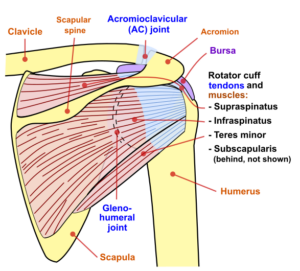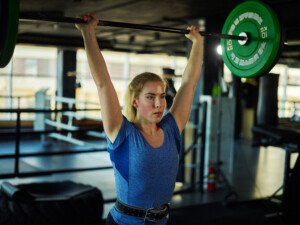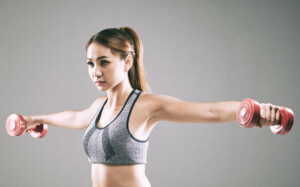If you think upright kettlebell rows are safer for your rotator cuff than are upright barbell rows, you’re very mistaken.
Here’s why you should avoid doing upright KB rows (as well as barbell rows).
Some people prefer the kettlebell for many strength training movements – and also because you might be thinking this actually is safer for your shoulder than using a barbell or pulleys.
Whatever your goals – be they stronger shoulders, bigger shoulders or more toned or shapelier shoulders – you absolutely do NOT need to include any type of upright row movement to achieve these goals.
“Neither of these exercises are our favorites, mostly because going through the full range of motion can cause impingement of the supraspinatus under the acromion — as you move higher up the body — which is one of the ways that the tendons get frayed, possibly leading to a fuller tear,” explains Dr. Megan McLain, PT, DPT, cofounder of Intuitive Choice Physical Therapy & Wellness in Atlanta, GA.
Reasons to Ditch the Kettlebell Upright Row
“This motion also sets up the muscles that attach to the shoulder blade (including two of the rotator cuff muscles) at a disadvantage to perform, because they are in an elongated position,” says Dr. McLain.
#1. Internal rotation of the shoulder joint. This will occur either with a single kettlebell held by both hands or a KB in each hand.
The risk is shoulder impingement, which involves the rotator cuff.
The motion closes up the joint space and crowds out the tendon of the supraspinatus muscle, causing it to rub on bone. This can eventually “fray” the surface of the tendon.

Jmarchin, CC
Internal rotation in this fashion is unnatural. When’s the last time you had to perform an upright row movement to pick something up in everyday life, let alone do it repeatedly?
No matter what you’re lifting or carrying around the house or on the job (babies, kids, garbage, furniture, boxes, rocks), you’re not going to use an upright row motion.
Someone who simply has no sense in how to properly lift something might actually upright-row it (I’ve seen children doing this with bags of garbage), but that doesn’t mean this is a natural or safe motion for the shoulder joints.
“Strength training should be functional, and yes, we may have to lift an object with two hands in front of our bodies during our daily lives,” says Dr. McLain.
“But you should only lift with your shoulder in this internally rotated position to below chest height and then flip your palms to face upward and change your grip to being at the base of the object.
“This allows the shoulders to be in external rotation, which is a much friendlier position for the shoulder and decreases impingement of the tendons.”
#2. Fails to mimic everyday movements. As just mentioned, this is not a natural motion.
Now before you point out that many popular strength training exercises do not mimic everyday activities, such as the leg curl, leg extension, triceps extension, skull crusher and decline press, you must realize that these other exercises aren’t nearly as risky as the kettlebell upright row.
Even with a light weight, the KB upright row can hurt the rotator cuff.
Though heavy leg extensions and a heavy decline, incline or flat press can strain the working joints and possibly injure tendons, this would much more likely occur using a very heavy weight (relative to the person’s strength and conditioning).
Upright rows with even a light kettlebell may still crowd out the supraspinatus tendon, potentially irritating it.
You Won’t Miss Anything
You will not miss out on getting stronger, getting caps, getting definition or attaining any other goal by foregoing the upright row with a kettlebell or other implement.
Simply stick to the basic shoulder exercises – and always make sure you employ excellent form.
The rotator cuff is not immune to injury from “safe” shoulder exercises.
You still need to warm up and not get ahead of yourself with weight loads.
Replacement exercises for the kettlebell upright row include the standing barbell and dumbbell press, seated dumbbell press, seated machine press, standing cable pulley press, front and side dumbbell raise with slightly bent arms, and front and side cable pulley raise with slightly bent arms. Avoid internal rotation with front and side raises.

Overhead dumbbell press. Shutterstock/Syda Productions

Overhead barbell press. Shutterstock/Comeback Images

Dumbbell side raise or lateral raise. Freepik/pressfoto
 Dr. Megan McLain, PT, DPT, puts her clients first while providing one-on-one in-home care. With physical therapy and health coaching services, Dr. McLain addresses all aspects such as physical barriers, mindset, accountability and knowledge that may be impacting the client’s experience.
Dr. Megan McLain, PT, DPT, puts her clients first while providing one-on-one in-home care. With physical therapy and health coaching services, Dr. McLain addresses all aspects such as physical barriers, mindset, accountability and knowledge that may be impacting the client’s experience.
 Lorra Garrick is a former personal trainer certified by the American Council on Exercise. At Bally Total Fitness she trained clients of all ages for fat loss, muscle building, fitness and improved health.
Lorra Garrick is a former personal trainer certified by the American Council on Exercise. At Bally Total Fitness she trained clients of all ages for fat loss, muscle building, fitness and improved health.
.



























